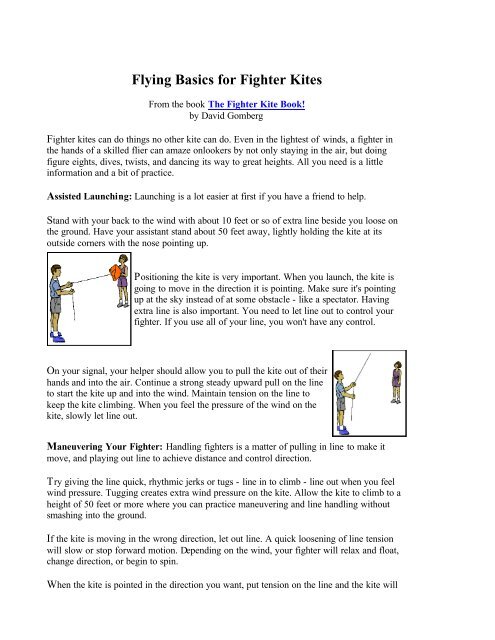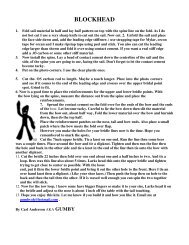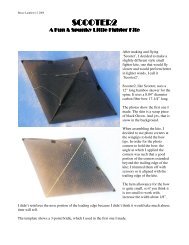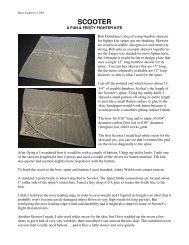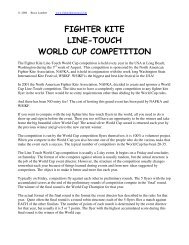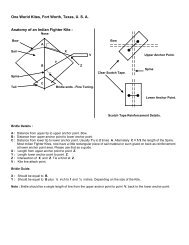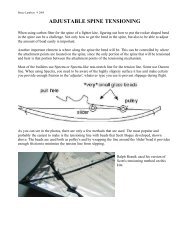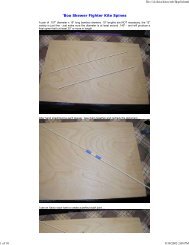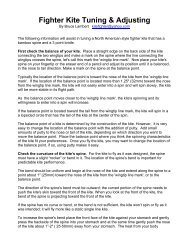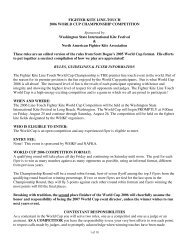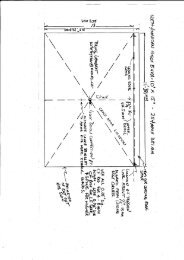Fighter Basics-Gomberg.pdf - fighterkitecentral.com
Fighter Basics-Gomberg.pdf - fighterkitecentral.com
Fighter Basics-Gomberg.pdf - fighterkitecentral.com
- No tags were found...
Create successful ePaper yourself
Turn your PDF publications into a flip-book with our unique Google optimized e-Paper software.
Flying <strong>Basics</strong> for <strong>Fighter</strong> KitesFrom the book The <strong>Fighter</strong> Kite Book!by David <strong>Gomberg</strong><strong>Fighter</strong> kites can do things no other kite can do. Even in the lightest of winds, a fighter inthe hands of a skilled flier can amaze onlookers by not only staying in the air, but doingfigure eights, dives, twists, and dancing its way to great heights. All you need is a littleinformation and a bit of practice.Assisted Launching: Launching is a lot easier at first if you have a friend to help.Stand with your back to the wind with about 10 feet or so of extra line beside you loose onthe ground. Have your assistant stand about 50 feet away, lightly holding the kite at itsoutside corners with the nose pointing up.Positioning the kite is very important. When you launch, the kite isgoing to move in the direction it is pointing. Make sure it's pointingup at the sky instead of at some obstacle - like a spectator. Havingextra line is also important. You need to let line out to control yourfighter. If you use all of your line, you won't have any control.On your signal, your helper should allow you to pull the kite out of theirhands and into the air. Continue a strong steady upward pull on the lineto start the kite up and into the wind. Maintain tension on the line tokeep the kite climbing. When you feel the pressure of the wind on thekite, slowly let line out.Maneuvering Your <strong>Fighter</strong>: Handling fighters is a matter of pulling in line to make itmove, and playing out line to achieve distance and control direction.Try giving the line quick, rhythmic jerks or tugs - line in to climb - line out when you feelwind pressure. Tugging creates extra wind pressure on the kite. Allow the kite to climb to aheight of 50 feet or more where you can practice maneuvering and line handling withoutsmashing into the ground.If the kite is moving in the wrong direction, let out line. A quick loosening of line tensionwill slow or stop forward motion. Depending on the wind, your fighter will relax and float,change direction, or begin to spin.When the kite is pointed in the direction you want, put tension on the line and the kite will
move in that direction. Pull in - either in a steady hand-over-hand motion for long, sustainedflights, or in sharp tugs to make the kite quickly dart a few feet.If your kite dives toward the ground, pulling on the line won't make it go up again. It willmake the kite zoom toward the ground even faster. Loosen the line. Let the kite be<strong>com</strong>eunstable. Then pull in when the kite points up and fly away from the crash. Your friendswill be amazed!Line handling is a two handed process. Don't ever let one hand freeuntil you have firm control of the line with the other hand. Hold theline near the tip or first joint of your index finger. Use your thumbas an anchor. Practice pulling in hand-over-hand and then lettingline out quickly.As you continue to practice, avoid slack line. Loose line leads tobad flying habits.Solo Launching: To launch without an assistant, grasp the nose of the kite with one handand hold the line in the other. Release the kite, let the wind carry it for a short distance, thenpull up on the line to gain height. Repeat this several times to get your desired elevation.Sometimes in light winds, hand launching can be difficult and you may prefer to begin witha bit more line in the air. At times like this, you may want to "create" a launching assistant.A fairly cooperative assistant can be made from sand, sticks,or almost any kind of prop for the kite. Simply lean yourfighter against the "assistant" and move back into the wind,playing out line as you go. When you are ready to launch,take in the slack line and lift the fighter into the air.With a little practice, your skill and reaction time will quickly improve. <strong>Fighter</strong> flying will
e<strong>com</strong>e almost as easy as getting out of bed in the morning -- which we admit is easier onsome days than on others.The <strong>Fighter</strong> Kite Book has seventy-five pages packed with information about fighter kiteflying, tuning, construction and <strong>com</strong>petition. It also contains tips from dozens ofinternationally recognized experts. Ask your local kite shop for The <strong>Fighter</strong> Kite Book from<strong>Gomberg</strong> Kite Productions, Intl.Ask your local kite store forThe <strong>Fighter</strong> Kite BookA Complete Flight Manual for <strong>Fighter</strong> Kitesby David <strong>Gomberg</strong>.


